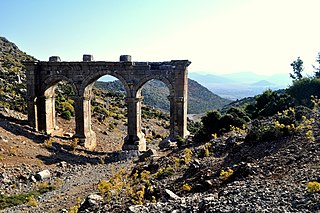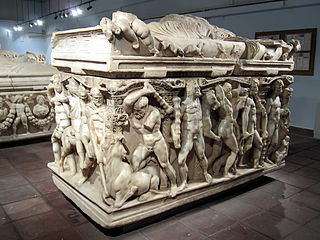
Nysa on the Maeander was an ancient city and bishopric of Asia Minor, whose remains are in the Sultanhisar district of Aydın Province of Turkey, 50 kilometres (31 mi) east of the Ionian city of Ephesus, and which remains a Latin Catholic titular see.

Ariassus or Ariassos was a town in Pisidia, Asia Minor built on a steep hillside about 50 kilometres inland from Attaleia.
Pednelissus or Petnelissus was a city on the border between Pamphylia and Pisidia in Asia Minor.

Tripolis on the Meander – also Neapolis, Apollonia, and Antoniopolis – was an ancient city on the borders of Phrygia, Caria and Lydia, on the northern bank of the upper course of the Maeander, and on the road leading from Sardes by Philadelphia to Laodicea ad Lycum. It was situated 20 km to the northwest of Hierapolis.
Parlais is a former Roman city of Pisidia.

Lyrbe was an ancient city and later episcopal see in the Roman province of Pamphylia Prima and is now a titular see.
Harpasa was a city and bishopric in ancient Caria in Roman Asia Minor, which only remains a Latin Catholic titular see.
Savatra, Sabatra, or Soatra was a city in the Roman province of Galatia, and subsequently the Byzantine province of Lycaonia.
Panemotichus or Panemoteichos was inland town in the late Roman province of Pamphylia Secunda. It was also a bishopric, a suffragan of the Perge, the metropolitan see of the province. It was inhabited during Roman and Byzantine times.

Tiberiopolis was a town in the Roman province of Phrygia Pacatiana, mentioned by Ptolemy, Socrates of Constantinople and Hierocles. At various times, it was considered as part of Phrygia, Isauria, and the late Roman province of Pisidia.
Cotenna or Kotenna was a city in the Roman province of Pamphylia I in Asia Minor. It corresponds to modern Gödene, near Konya, Turkey.
Trapezopolis or Trapezoupolis (Τραπεζούπολις) was a city of ancient Caria, and later in the late Roman province of Phrygia Pacatiana Prima.
Acalissus or Akalissos was a town of ancient Lycia, an early bishopric, and remains a titular see of the Roman Catholic Church. Coins were minted at Acalissus, some of which are housed at numismatic collections.
Eudocias or Eudocia was an ancient town in the Roman province of Pamphylia Secunda, in the neighbourhood of Termessus.

Nisa, also Nyssa (Νύσσα) or Nysa (Νύσα) or Neisa (Νείσα), was a town in ancient Lycia near the source of the River Xanthus.
Comama was a town in the late Roman province of Pamphylia Secunda. It has been called Pisidian, not as being in `Pisidia, but as founded on what was the Pisidian frontier of the Roman Empire.

Etenna was a city in the late Roman province of Pamphylia Prima. Centuries earlier, it was reckoned as belonging to Pisidia, as by Polybius, who wrote that in 218 BC the people of Etenna "who live in the highlands of Pisidia above Side" provided 8000 hoplites to assist the Seleucid usurper Achaeus.

Setae or Setai, or Settae or Settai (Σέτται), or Saettae or Saittai or Saittae (Σαίτται) was a town of ancient Lydia, located at Sidas Kaleh in Modern Turkey. The ruins of that town consist of a stadium, tombs and ruins of several temples. The town is not mentioned by any of the earlier writers, but appears in Ptolemy and Hierocles.

Isauropolis was a Roman and Byzantine-era town in southern Turkey.

Isinda was a town of ancient Pisidia.










